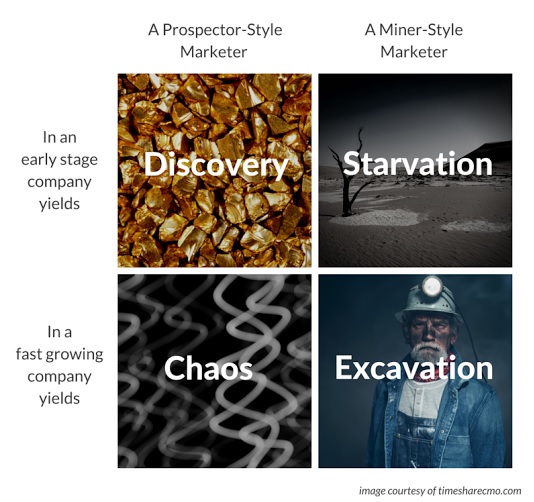Growth hacking is failing most of us — because most of us don’t understand that what works for companies with a growing customer base doesn’t work for earlier-stage companies still looking for product-market fit; and vice versa.
There are actually two very different types of growth hacking, and if you’re not using the right method, you could well sink your company.
Take Andy Johns and Sean Ellis, for example. They’re two of the most highly regarded growth hackers in the world, and yet they’re completely different people who work in completely different ways. Their different approaches reflect why it’s so hard to define what a growth hacker is.
Andy Johns, formerly of Twitter and Facebook and now the highly regarded head of growth of Wealthfront, was raised as a farmer in the Central Valley of California. He speaks with the cadence of someone experienced in patiently husbanding cash crops to market. He’s preternaturally calm, disciplined, a numbers-oriented data scientist.
Sean Ellis, founder and CEO of marketing technology company Qualaroo and the popular GrowthHackers.com community, was the first marketer at Dropbox, Lookout, and LogMeIn and is widely credited with coining the term Growth Hacker five years ago. He is Johns’ cognitive opposite. Ellis is a fast talking polymath who started his career in direct sales before there was an Internet to advertise on. His tenacious “hustle” to execute, his leaps of insight in leveraging new channels and technology, and his shark-like constant motion is textbook entrepreneur material — an enormous asset to any early stage company. Indeed, he was part of the team that started and sold one of the earliest big players in the ads market — Uproar — to Vivendi Universal after getting it to a peak valuation of $1 billion.
Unsurprisingly Ellis is a serial entrepreneur, and Johns is now leading growth inside yet another unicorn.
 Where Johns makes small changes on enormous sites like Twitter to get 30,000 more visitors a day, Ellis is constantly on the lookout for the next arbitrage, the next way to stay ahead of his competition, the next channel to leverage, the next idea to tweak into a creative asset.
Where Johns makes small changes on enormous sites like Twitter to get 30,000 more visitors a day, Ellis is constantly on the lookout for the next arbitrage, the next way to stay ahead of his competition, the next channel to leverage, the next idea to tweak into a creative asset.
In gold rush terms, Ellis is the prospector, and Johns is the miner. And it turns out the two archetypes are a perfect match for the two most important company stages: startup and growth. Prospector growth hackers do best in early-stage companies that are still working to find perfect product-market fit and that don’t yet have their first big money invested. Miner growth hackers do best in post product-market fit conditions, when their skills are needed to excavate datasets in large and/or fast-growing businesses and find ways to turn those insights into even more growth.
Put the wrong growth hacker in the wrong company, and disaster happens. Send a Miner to prospect, and she might spend years digging patiently for decades in the Arizona desert, never striking gold. Conversely, if you send a Prospector to mine the gold, she’d probably spend half the resources looking for silver instead.
Still, despite their different approaches, Prospectors and Miners have seven key characteristics in common:
1. Data-driven: Growth hackers make all decisions based on data. Prospectors evaluate their results with data, but Miners also use data to decide which problems to solve. By definition a Prospector may not know where the gold is, so she has to take chances and try things, sometimes with very little data, to see if there’s a vein of gold. But she uses data to evaluate the success of that test. Work decisions thus become not about WHO is right, but WHAT is right. This makes for a faster and less political decision-making process, a critical factor for increasing speed in companies of all sizes.
2. Technical aptitude: In tech companies, both Prospectors and Miners are friends of engineers because the website is the company and nothing gets done without developers. Good growth hackers have a strong aptitude for working with engineering via agile methods, design skills, and technical knowledge. Neither Ellis nor Johns is an engineer. But like Steve Jobs, they learned enough about engineering to understand how to work with developers effectively. In a non-tech company, the technical aptitude needs to be in the areas required to effectively implement the tactics required.
3. Customer empathy: We’re talking about marketing, after all. So every growth hacker cares about customers. Prospectors talk to every single one of the first 1-100 or so customers to understand where the product must evolve to meet the customer expectation. Miners, well, they mine customer and usage data to create better experiences. “Developers are so busy coding,” Ellis notes, “that they often have little perspective on the real-world experiences of the customers using the product.” A great growth hacker’s job is always bridging that gap.
4. Team orientation: Because decisions are made with data and don’t rely on intuitive leaps of individuals, the best growth hackers don’t have big egos. No growth hacker has the time or energy to come up with all the ideas and implement them. They need to be able to work within teams to design, execute, measure, and improve key performance indicators. Because the data measures success, growth hackers have a mindset of “how can I help,” not “that isn’t my job.”
5. Curiosity: Good growth hackers must have that strong sense of “what if” that is common in science. Prospectors will be curious about early customers’ similarities and about trying the most recent and creative tactics, riffing off case studies and testing new platforms. Miners will be curious about data and what it reveals in terms of opportunities. Whether it’s teaching themselves to code, deep-diving into data analysis, learning photoshop, or a tackling a new marketing platform, growth hackers at all levels should be eager to tackle any challenge the business presents.
6. Focus/Discipline: Both Prospectors and Miners need to be focused and disciplined. Time is a factor in both roles. Prospectors can’t check every square inch of earth, and Miners can’t chase every vein of gold at the same time. This also means it’s critical for growth hackers to have solid project management, follow through, and detail orientation skills — or be supported by team members who do.
7. Grit: Just like entrepreneurs, growth hackers have to have grit. A hypothesis-driven approach can mean many, many points of failure. In the early days, success may seem very far away indeed. Think about AirBnB founders sleeping on air mattresses and eating cereal for years. Miners have to have the grit that comes from knowing not every change will be a hit and that big changes will take time to socialize.
Up next:
Pg. 2: How to be a Prospector-style growth hacker
Pg. 3: How to build out a Miner-style growth hacking operation

